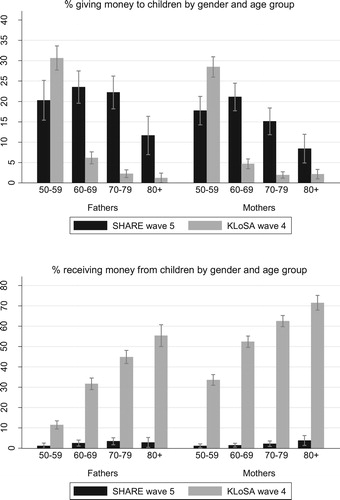Figures & data
Figure 1. Exchanges of financial support* between parents aged 50+ and their children (Italy 2013; Korea 2012). Source: Author’s analysis of data from SHARE wave 5 (Citation2013) and KLoSA wave 4 (KEIS, Citation2014). *SHARE codes financial transfers of €250 or above; in KLoSA, only financial transfers equal to or above 285,700 Won are considered (in 2012 €1 =|KRW 1143 using Purchasing Power Parity).

Table 1. Percentage of grandparents aged 50+ looking after grandchildren aged 0–10 without the presence of parents over the 12 months preceding the interview, by gender and age group (Italy 2013; Korea 2012).
Table 2. Percentage of parents aged 50+ receiving instrumental help and personal care from children in the 12 months preceding the interview, by gender, age group and ADL status (Italy 2013; Korea 2012).
Figure 2. Selected coefficients* from fully-adjusted logistic regressions for the probability of living with children, by gender (Italy 2013; Korea 2012). Source: Author’s analysis of data from SHARE wave 5 (Citation2013) and KLoSA wave 4 (KEIS, Citation2014). *Additional controls (not shown): Parental education and working status, household wealth, household rural dwelling and presence of grandchildren. All estimates are reported in Supplementary Tables 4 and 5.

